Internet of Things for Smart Healthcare: Technologies, Challenges
VerifiedAdded on 2023/04/25
|9
|2127
|415
Report
AI Summary
This report provides an overview of the Internet of Things (IoT) in the context of smart healthcare, focusing on the technologies, challenges, and opportunities within this evolving field. It begins by defining IoT and its relevance to healthcare, highlighting pioneering works and proposing a standardized model for future end-to-end IoT healthcare systems. The report details the inclusion criteria used for literature analysis, including the selection of 115 publications from an initial pool of 427, based on relevance and publication date, while excluding articles in foreign languages or those lacking a clear definition of IoT. Key considerations for the proposed model include communication systems, data transfer methods, and data storage solutions, classifying the system based on communication systems, cloud-based infrastructure, and wearable devices. Wearable sensors for monitoring vital signs such as pulse, respiratory rate, body temperature, and blood pressure are discussed, emphasizing non-obtrusive and non-invasive options. The report also addresses the organization of subsections within the proposed solution, focusing on wearable systems, communication systems, and cloud storage, with an emphasis on secure data management and accessibility for healthcare professionals. Finally, the report touches on system classification, comparing previous works and summarizing selected papers to provide a comprehensive overview of the current state and future directions of IoT in smart healthcare.
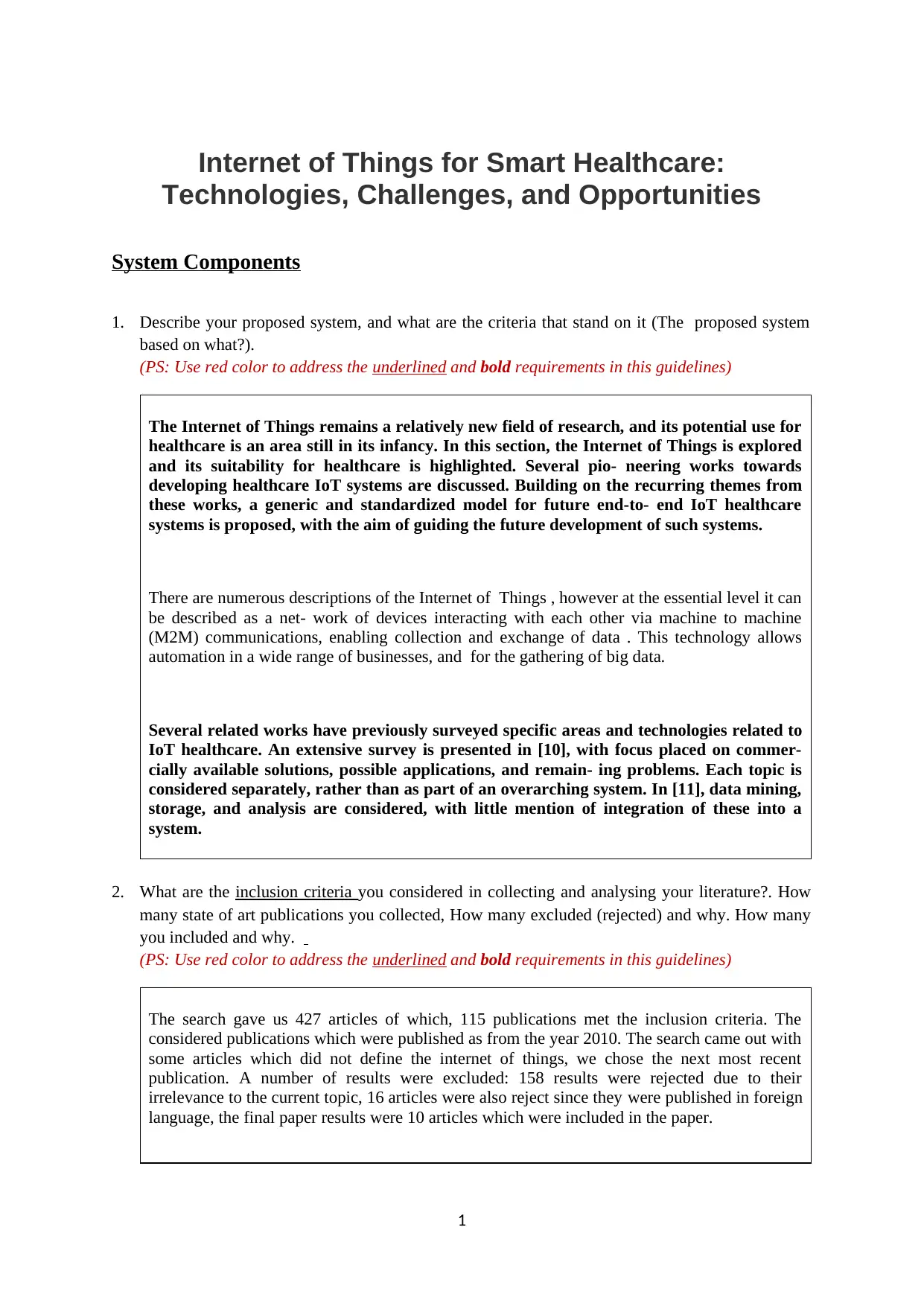
Internet of Things for Smart Healthcare:
Technologies, Challenges, and Opportunities
System Components
1. Describe your proposed system, and what are the criteria that stand on it (The proposed system
based on what?).
(PS: Use red color to address the underlined and bold requirements in this guidelines)
The Internet of Things remains a relatively new field of research, and its potential use for
healthcare is an area still in its infancy. In this section, the Internet of Things is explored
and its suitability for healthcare is highlighted. Several pio- neering works towards
developing healthcare IoT systems are discussed. Building on the recurring themes from
these works, a generic and standardized model for future end-to- end IoT healthcare
systems is proposed, with the aim of guiding the future development of such systems.
There are numerous descriptions of the Internet of Things , however at the essential level it can
be described as a net- work of devices interacting with each other via machine to machine
(M2M) communications, enabling collection and exchange of data . This technology allows
automation in a wide range of businesses, and for the gathering of big data.
Several related works have previously surveyed specific areas and technologies related to
IoT healthcare. An extensive survey is presented in [10], with focus placed on commer-
cially available solutions, possible applications, and remain- ing problems. Each topic is
considered separately, rather than as part of an overarching system. In [11], data mining,
storage, and analysis are considered, with little mention of integration of these into a
system.
2. What are the inclusion criteria you considered in collecting and analysing your literature?. How
many state of art publications you collected, How many excluded (rejected) and why. How many
you included and why.
(PS: Use red color to address the underlined and bold requirements in this guidelines)
The search gave us 427 articles of which, 115 publications met the inclusion criteria. The
considered publications which were published as from the year 2010. The search came out with
some articles which did not define the internet of things, we chose the next most recent
publication. A number of results were excluded: 158 results were rejected due to their
irrelevance to the current topic, 16 articles were also reject since they were published in foreign
language, the final paper results were 10 articles which were included in the paper.
1
Technologies, Challenges, and Opportunities
System Components
1. Describe your proposed system, and what are the criteria that stand on it (The proposed system
based on what?).
(PS: Use red color to address the underlined and bold requirements in this guidelines)
The Internet of Things remains a relatively new field of research, and its potential use for
healthcare is an area still in its infancy. In this section, the Internet of Things is explored
and its suitability for healthcare is highlighted. Several pio- neering works towards
developing healthcare IoT systems are discussed. Building on the recurring themes from
these works, a generic and standardized model for future end-to- end IoT healthcare
systems is proposed, with the aim of guiding the future development of such systems.
There are numerous descriptions of the Internet of Things , however at the essential level it can
be described as a net- work of devices interacting with each other via machine to machine
(M2M) communications, enabling collection and exchange of data . This technology allows
automation in a wide range of businesses, and for the gathering of big data.
Several related works have previously surveyed specific areas and technologies related to
IoT healthcare. An extensive survey is presented in [10], with focus placed on commer-
cially available solutions, possible applications, and remain- ing problems. Each topic is
considered separately, rather than as part of an overarching system. In [11], data mining,
storage, and analysis are considered, with little mention of integration of these into a
system.
2. What are the inclusion criteria you considered in collecting and analysing your literature?. How
many state of art publications you collected, How many excluded (rejected) and why. How many
you included and why.
(PS: Use red color to address the underlined and bold requirements in this guidelines)
The search gave us 427 articles of which, 115 publications met the inclusion criteria. The
considered publications which were published as from the year 2010. The search came out with
some articles which did not define the internet of things, we chose the next most recent
publication. A number of results were excluded: 158 results were rejected due to their
irrelevance to the current topic, 16 articles were also reject since they were published in foreign
language, the final paper results were 10 articles which were included in the paper.
1
Paraphrase This Document
Need a fresh take? Get an instant paraphrase of this document with our AI Paraphraser
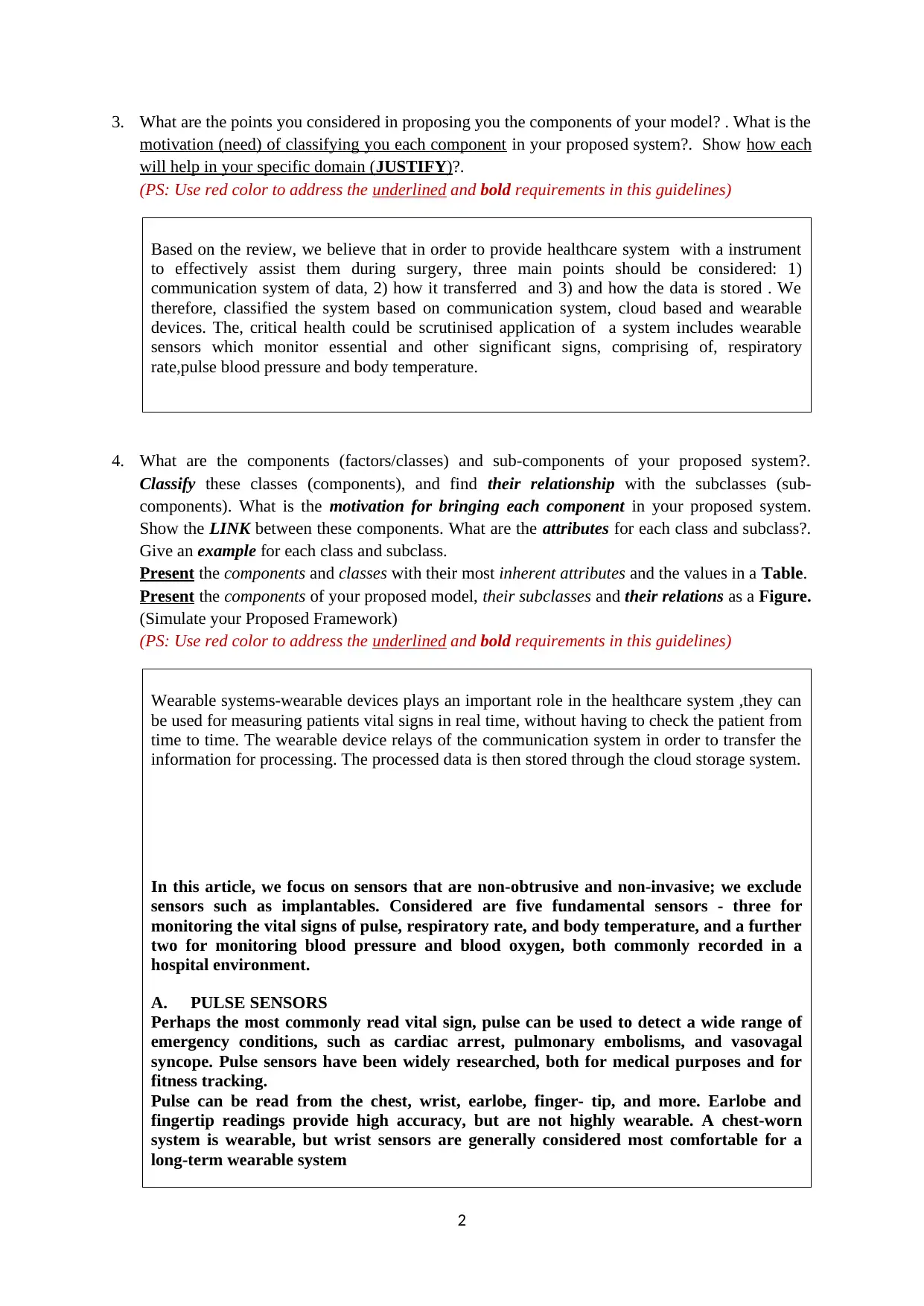
3. What are the points you considered in proposing you the components of your model? . What is the
motivation (need) of classifying you each component in your proposed system?. Show how each
will help in your specific domain (JUSTIFY)?.
(PS: Use red color to address the underlined and bold requirements in this guidelines)
Based on the review, we believe that in order to provide healthcare system with a instrument
to effectively assist them during surgery, three main points should be considered: 1)
communication system of data, 2) how it transferred and 3) and how the data is stored . We
therefore, classified the system based on communication system, cloud based and wearable
devices. The, critical health could be scrutinised application of a system includes wearable
sensors which monitor essential and other significant signs, comprising of, respiratory
rate,pulse blood pressure and body temperature.
4. What are the components (factors/classes) and sub-components of your proposed system?.
Classify these classes (components), and find their relationship with the subclasses (sub-
components). What is the motivation for bringing each component in your proposed system.
Show the LINK between these components. What are the attributes for each class and subclass?.
Give an example for each class and subclass.
Present the components and classes with their most inherent attributes and the values in a Table.
Present the components of your proposed model, their subclasses and their relations as a Figure.
(Simulate your Proposed Framework)
(PS: Use red color to address the underlined and bold requirements in this guidelines)
Wearable systems-wearable devices plays an important role in the healthcare system ,they can
be used for measuring patients vital signs in real time, without having to check the patient from
time to time. The wearable device relays of the communication system in order to transfer the
information for processing. The processed data is then stored through the cloud storage system.
In this article, we focus on sensors that are non-obtrusive and non-invasive; we exclude
sensors such as implantables. Considered are five fundamental sensors - three for
monitoring the vital signs of pulse, respiratory rate, and body temperature, and a further
two for monitoring blood pressure and blood oxygen, both commonly recorded in a
hospital environment.
A. PULSE SENSORS
Perhaps the most commonly read vital sign, pulse can be used to detect a wide range of
emergency conditions, such as cardiac arrest, pulmonary embolisms, and vasovagal
syncope. Pulse sensors have been widely researched, both for medical purposes and for
fitness tracking.
Pulse can be read from the chest, wrist, earlobe, finger- tip, and more. Earlobe and
fingertip readings provide high accuracy, but are not highly wearable. A chest-worn
system is wearable, but wrist sensors are generally considered most comfortable for a
long-term wearable system
2
motivation (need) of classifying you each component in your proposed system?. Show how each
will help in your specific domain (JUSTIFY)?.
(PS: Use red color to address the underlined and bold requirements in this guidelines)
Based on the review, we believe that in order to provide healthcare system with a instrument
to effectively assist them during surgery, three main points should be considered: 1)
communication system of data, 2) how it transferred and 3) and how the data is stored . We
therefore, classified the system based on communication system, cloud based and wearable
devices. The, critical health could be scrutinised application of a system includes wearable
sensors which monitor essential and other significant signs, comprising of, respiratory
rate,pulse blood pressure and body temperature.
4. What are the components (factors/classes) and sub-components of your proposed system?.
Classify these classes (components), and find their relationship with the subclasses (sub-
components). What is the motivation for bringing each component in your proposed system.
Show the LINK between these components. What are the attributes for each class and subclass?.
Give an example for each class and subclass.
Present the components and classes with their most inherent attributes and the values in a Table.
Present the components of your proposed model, their subclasses and their relations as a Figure.
(Simulate your Proposed Framework)
(PS: Use red color to address the underlined and bold requirements in this guidelines)
Wearable systems-wearable devices plays an important role in the healthcare system ,they can
be used for measuring patients vital signs in real time, without having to check the patient from
time to time. The wearable device relays of the communication system in order to transfer the
information for processing. The processed data is then stored through the cloud storage system.
In this article, we focus on sensors that are non-obtrusive and non-invasive; we exclude
sensors such as implantables. Considered are five fundamental sensors - three for
monitoring the vital signs of pulse, respiratory rate, and body temperature, and a further
two for monitoring blood pressure and blood oxygen, both commonly recorded in a
hospital environment.
A. PULSE SENSORS
Perhaps the most commonly read vital sign, pulse can be used to detect a wide range of
emergency conditions, such as cardiac arrest, pulmonary embolisms, and vasovagal
syncope. Pulse sensors have been widely researched, both for medical purposes and for
fitness tracking.
Pulse can be read from the chest, wrist, earlobe, finger- tip, and more. Earlobe and
fingertip readings provide high accuracy, but are not highly wearable. A chest-worn
system is wearable, but wrist sensors are generally considered most comfortable for a
long-term wearable system
2
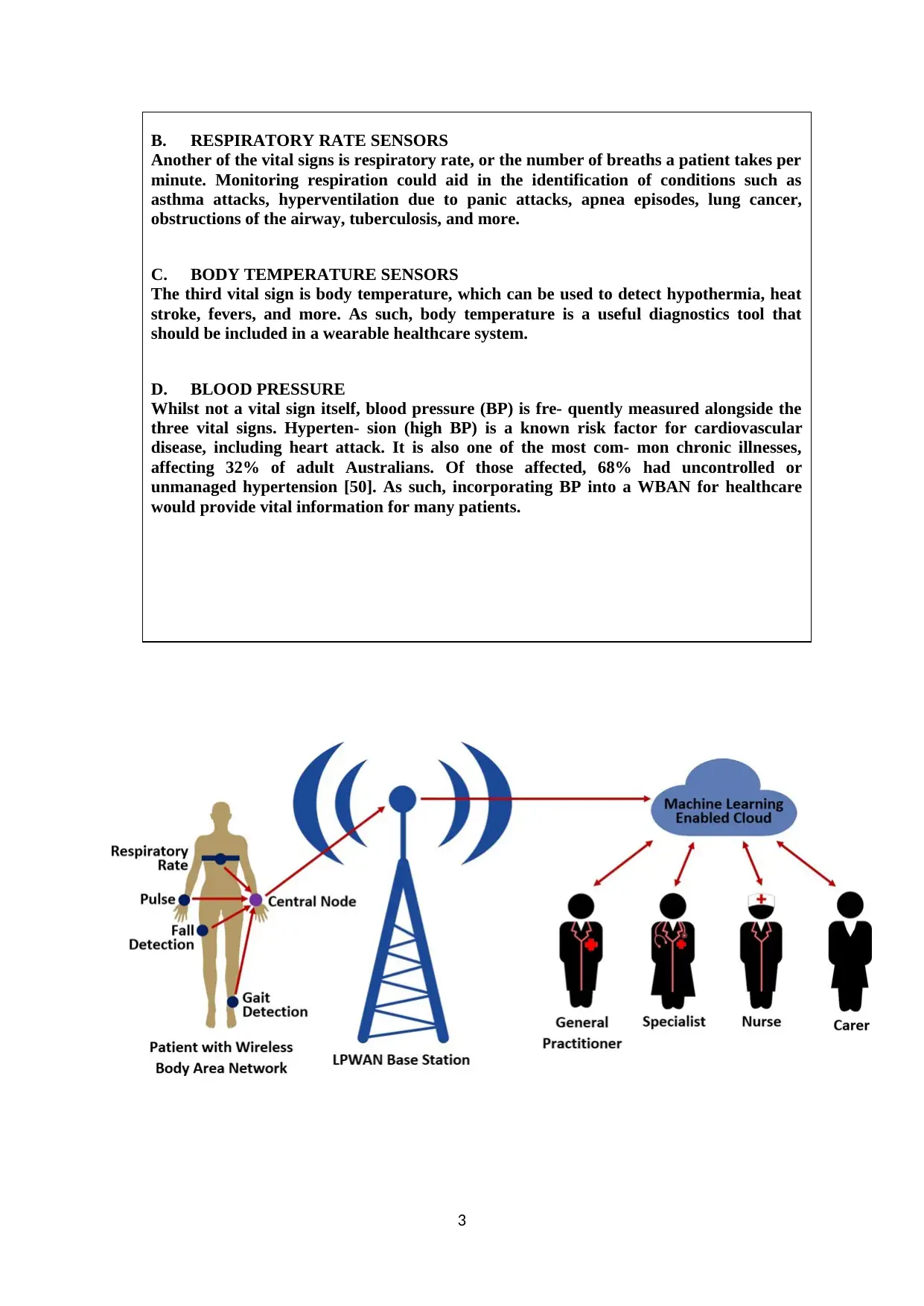
B. RESPIRATORY RATE SENSORS
Another of the vital signs is respiratory rate, or the number of breaths a patient takes per
minute. Monitoring respiration could aid in the identification of conditions such as
asthma attacks, hyperventilation due to panic attacks, apnea episodes, lung cancer,
obstructions of the airway, tuberculosis, and more.
C. BODY TEMPERATURE SENSORS
The third vital sign is body temperature, which can be used to detect hypothermia, heat
stroke, fevers, and more. As such, body temperature is a useful diagnostics tool that
should be included in a wearable healthcare system.
D. BLOOD PRESSURE
Whilst not a vital sign itself, blood pressure (BP) is fre- quently measured alongside the
three vital signs. Hyperten- sion (high BP) is a known risk factor for cardiovascular
disease, including heart attack. It is also one of the most com- mon chronic illnesses,
affecting 32% of adult Australians. Of those affected, 68% had uncontrolled or
unmanaged hypertension [50]. As such, incorporating BP into a WBAN for healthcare
would provide vital information for many patients.
3
Another of the vital signs is respiratory rate, or the number of breaths a patient takes per
minute. Monitoring respiration could aid in the identification of conditions such as
asthma attacks, hyperventilation due to panic attacks, apnea episodes, lung cancer,
obstructions of the airway, tuberculosis, and more.
C. BODY TEMPERATURE SENSORS
The third vital sign is body temperature, which can be used to detect hypothermia, heat
stroke, fevers, and more. As such, body temperature is a useful diagnostics tool that
should be included in a wearable healthcare system.
D. BLOOD PRESSURE
Whilst not a vital sign itself, blood pressure (BP) is fre- quently measured alongside the
three vital signs. Hyperten- sion (high BP) is a known risk factor for cardiovascular
disease, including heart attack. It is also one of the most com- mon chronic illnesses,
affecting 32% of adult Australians. Of those affected, 68% had uncontrolled or
unmanaged hypertension [50]. As such, incorporating BP into a WBAN for healthcare
would provide vital information for many patients.
3
⊘ This is a preview!⊘
Do you want full access?
Subscribe today to unlock all pages.

Trusted by 1+ million students worldwide
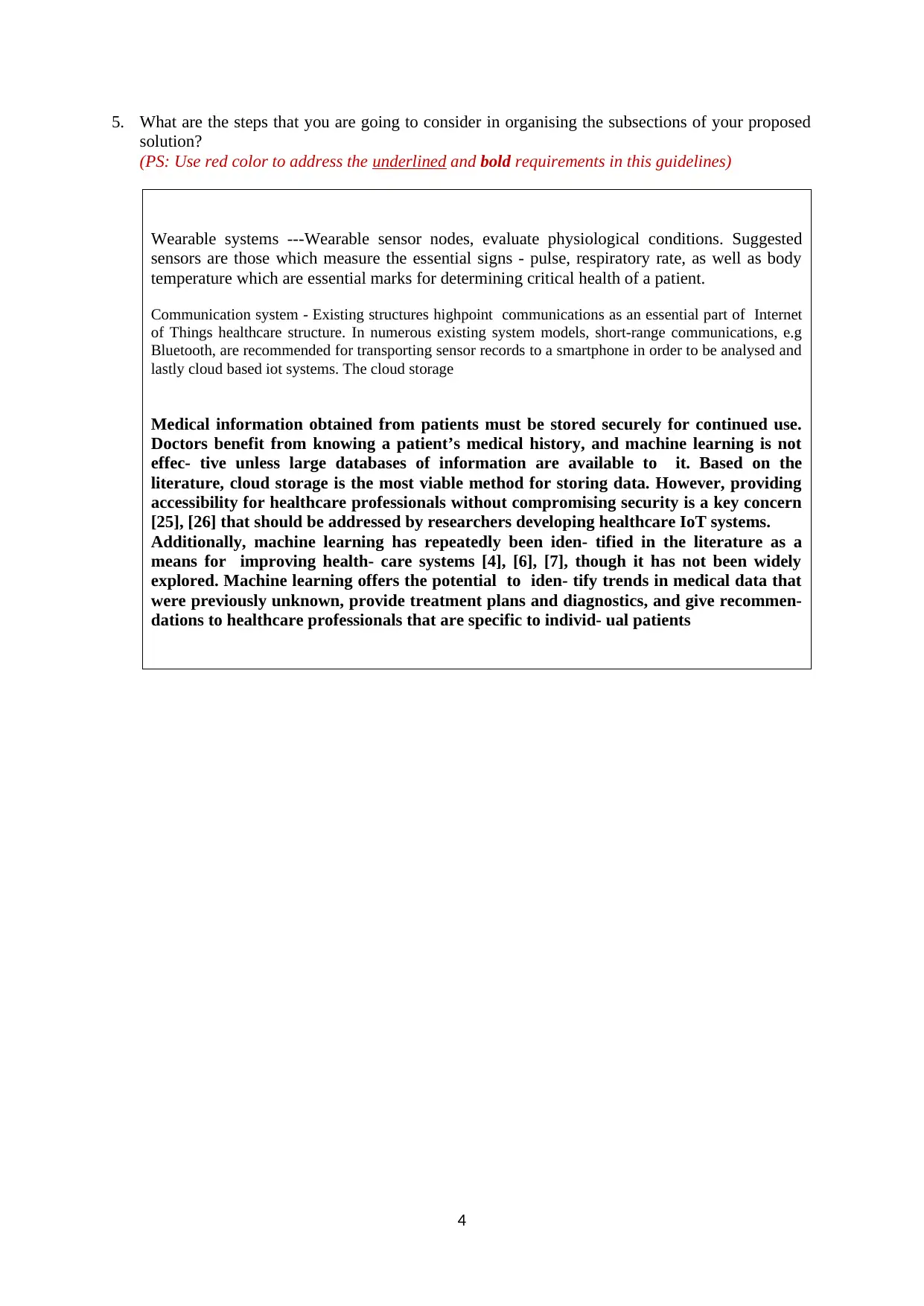
5. What are the steps that you are going to consider in organising the subsections of your proposed
solution?
(PS: Use red color to address the underlined and bold requirements in this guidelines)
Wearable systems ---Wearable sensor nodes, evaluate physiological conditions. Suggested
sensors are those which measure the essential signs - pulse, respiratory rate, as well as body
temperature which are essential marks for determining critical health of a patient.
Communication system - Existing structures highpoint communications as an essential part of Internet
of Things healthcare structure. In numerous existing system models, short-range communications, e.g
Bluetooth, are recommended for transporting sensor records to a smartphone in order to be analysed and
lastly cloud based iot systems. The cloud storage
Medical information obtained from patients must be stored securely for continued use.
Doctors benefit from knowing a patient’s medical history, and machine learning is not
effec- tive unless large databases of information are available to it. Based on the
literature, cloud storage is the most viable method for storing data. However, providing
accessibility for healthcare professionals without compromising security is a key concern
[25], [26] that should be addressed by researchers developing healthcare IoT systems.
Additionally, machine learning has repeatedly been iden- tified in the literature as a
means for improving health- care systems [4], [6], [7], though it has not been widely
explored. Machine learning offers the potential to iden- tify trends in medical data that
were previously unknown, provide treatment plans and diagnostics, and give recommen-
dations to healthcare professionals that are specific to individ- ual patients
4
solution?
(PS: Use red color to address the underlined and bold requirements in this guidelines)
Wearable systems ---Wearable sensor nodes, evaluate physiological conditions. Suggested
sensors are those which measure the essential signs - pulse, respiratory rate, as well as body
temperature which are essential marks for determining critical health of a patient.
Communication system - Existing structures highpoint communications as an essential part of Internet
of Things healthcare structure. In numerous existing system models, short-range communications, e.g
Bluetooth, are recommended for transporting sensor records to a smartphone in order to be analysed and
lastly cloud based iot systems. The cloud storage
Medical information obtained from patients must be stored securely for continued use.
Doctors benefit from knowing a patient’s medical history, and machine learning is not
effec- tive unless large databases of information are available to it. Based on the
literature, cloud storage is the most viable method for storing data. However, providing
accessibility for healthcare professionals without compromising security is a key concern
[25], [26] that should be addressed by researchers developing healthcare IoT systems.
Additionally, machine learning has repeatedly been iden- tified in the literature as a
means for improving health- care systems [4], [6], [7], though it has not been widely
explored. Machine learning offers the potential to iden- tify trends in medical data that
were previously unknown, provide treatment plans and diagnostics, and give recommen-
dations to healthcare professionals that are specific to individ- ual patients
4
Paraphrase This Document
Need a fresh take? Get an instant paraphrase of this document with our AI Paraphraser
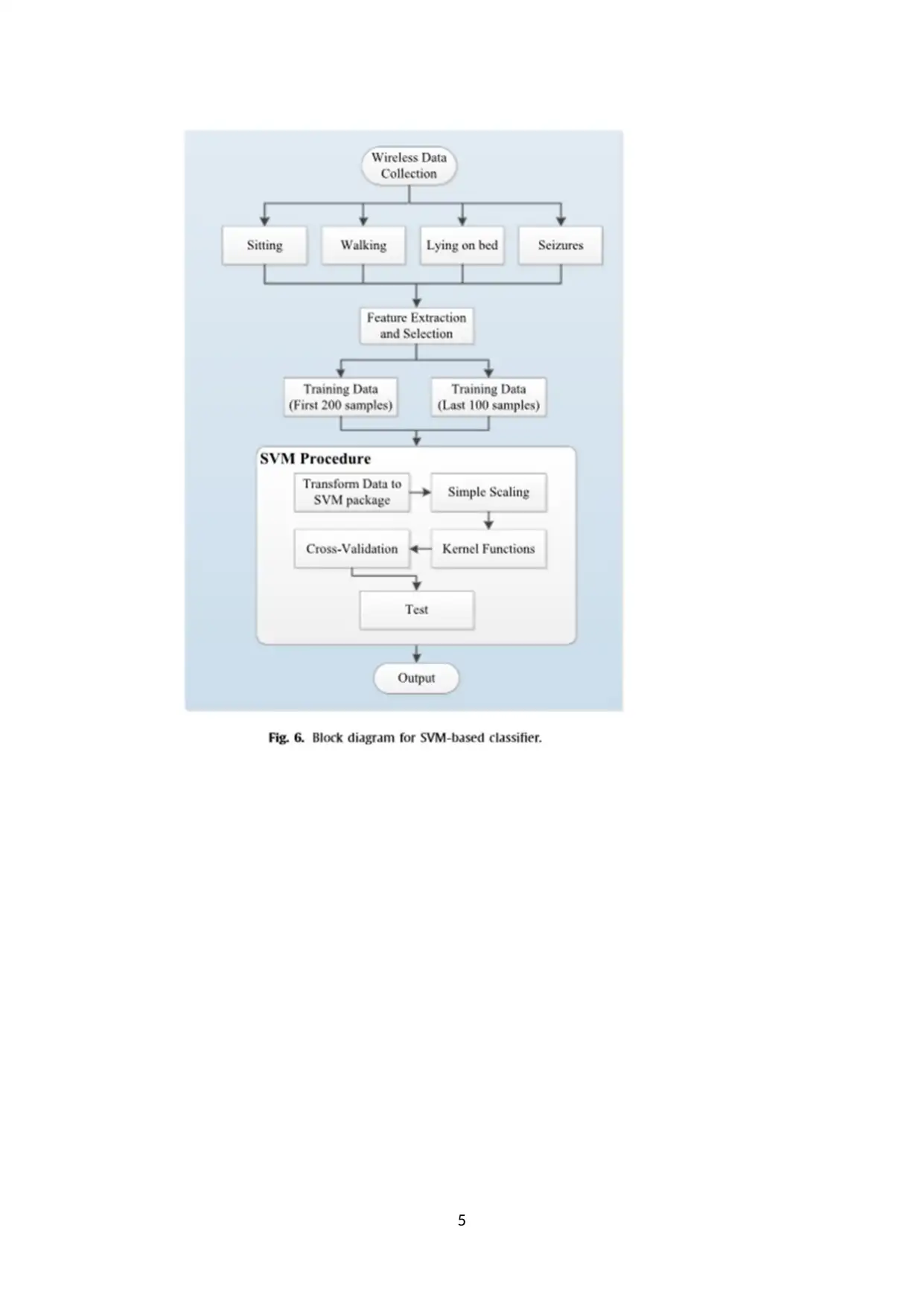
5
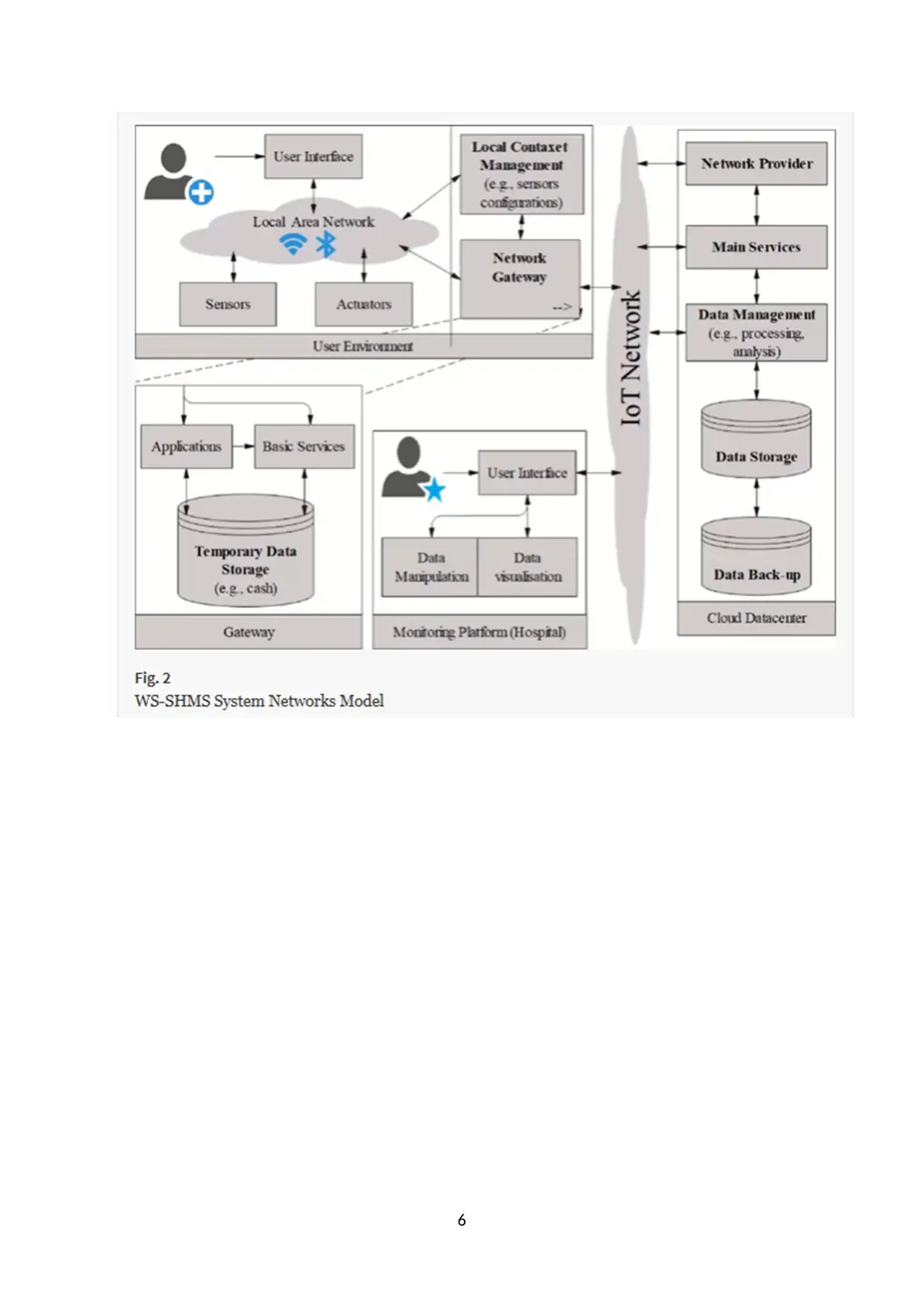
6
⊘ This is a preview!⊘
Do you want full access?
Subscribe today to unlock all pages.

Trusted by 1+ million students worldwide
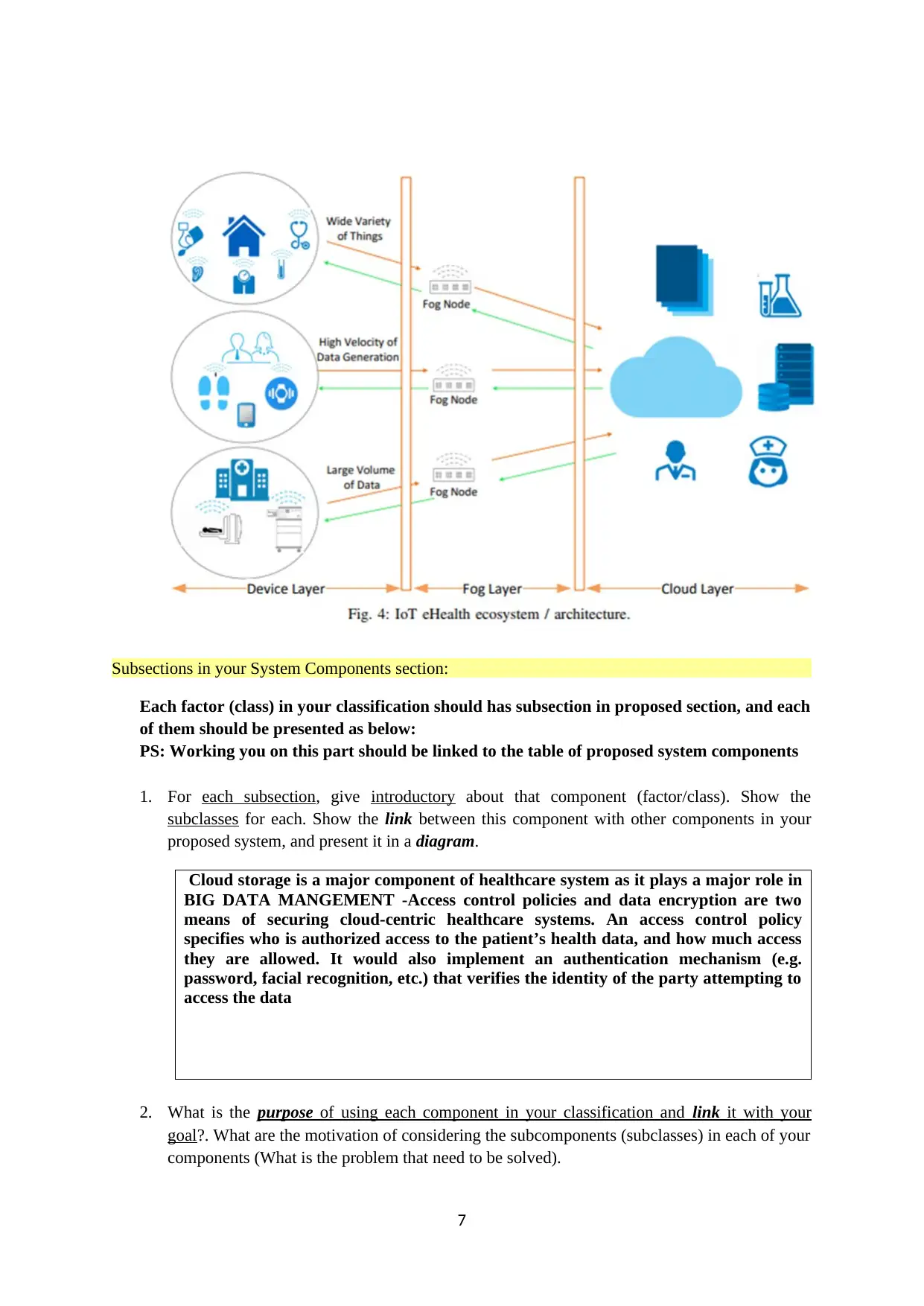
Subsections in your System Components section:
Each factor (class) in your classification should has subsection in proposed section, and each
of them should be presented as below:
PS: Working you on this part should be linked to the table of proposed system components
1. For each subsection, give introductory about that component (factor/class). Show the
subclasses for each. Show the link between this component with other components in your
proposed system, and present it in a diagram.
Cloud storage is a major component of healthcare system as it plays a major role in
BIG DATA MANGEMENT -Access control policies and data encryption are two
means of securing cloud-centric healthcare systems. An access control policy
specifies who is authorized access to the patient’s health data, and how much access
they are allowed. It would also implement an authentication mechanism (e.g.
password, facial recognition, etc.) that verifies the identity of the party attempting to
access the data
2. What is the purpose of using each component in your classification and link it with your
goal?. What are the motivation of considering the subcomponents (subclasses) in each of your
components (What is the problem that need to be solved).
7
Each factor (class) in your classification should has subsection in proposed section, and each
of them should be presented as below:
PS: Working you on this part should be linked to the table of proposed system components
1. For each subsection, give introductory about that component (factor/class). Show the
subclasses for each. Show the link between this component with other components in your
proposed system, and present it in a diagram.
Cloud storage is a major component of healthcare system as it plays a major role in
BIG DATA MANGEMENT -Access control policies and data encryption are two
means of securing cloud-centric healthcare systems. An access control policy
specifies who is authorized access to the patient’s health data, and how much access
they are allowed. It would also implement an authentication mechanism (e.g.
password, facial recognition, etc.) that verifies the identity of the party attempting to
access the data
2. What is the purpose of using each component in your classification and link it with your
goal?. What are the motivation of considering the subcomponents (subclasses) in each of your
components (What is the problem that need to be solved).
7
Paraphrase This Document
Need a fresh take? Get an instant paraphrase of this document with our AI Paraphraser
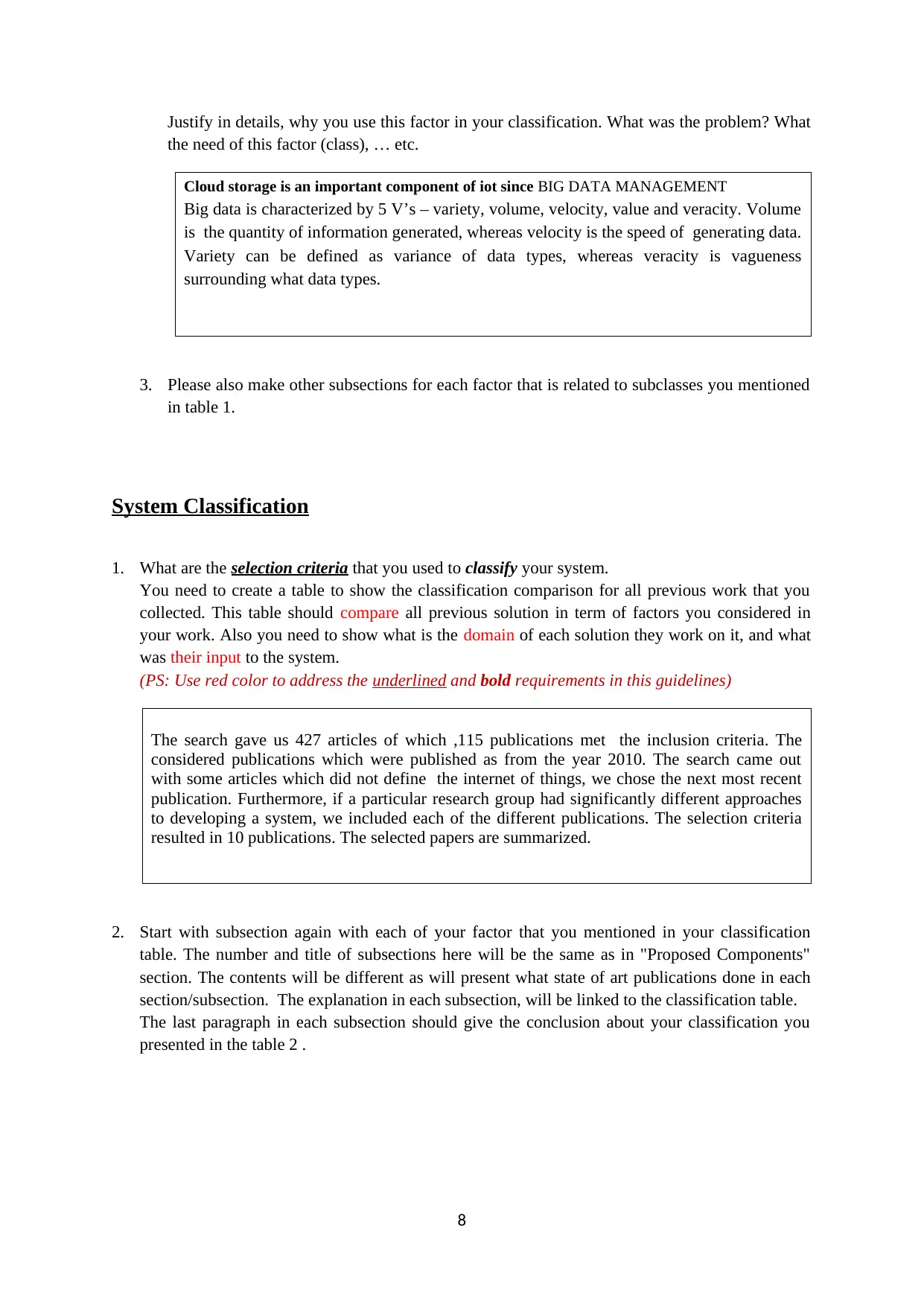
Justify in details, why you use this factor in your classification. What was the problem? What
the need of this factor (class), … etc.
Cloud storage is an important component of iot since BIG DATA MANAGEMENT
Big data is characterized by 5 V’s – variety, volume, velocity, value and veracity. Volume
is the quantity of information generated, whereas velocity is the speed of generating data.
Variety can be defined as variance of data types, whereas veracity is vagueness
surrounding what data types.
3. Please also make other subsections for each factor that is related to subclasses you mentioned
in table 1.
System Classification
1. What are the selection criteria that you used to classify your system.
You need to create a table to show the classification comparison for all previous work that you
collected. This table should compare all previous solution in term of factors you considered in
your work. Also you need to show what is the domain of each solution they work on it, and what
was their input to the system.
(PS: Use red color to address the underlined and bold requirements in this guidelines)
The search gave us 427 articles of which ,115 publications met the inclusion criteria. The
considered publications which were published as from the year 2010. The search came out
with some articles which did not define the internet of things, we chose the next most recent
publication. Furthermore, if a particular research group had significantly different approaches
to developing a system, we included each of the different publications. The selection criteria
resulted in 10 publications. The selected papers are summarized.
2. Start with subsection again with each of your factor that you mentioned in your classification
table. The number and title of subsections here will be the same as in "Proposed Components"
section. The contents will be different as will present what state of art publications done in each
section/subsection. The explanation in each subsection, will be linked to the classification table.
The last paragraph in each subsection should give the conclusion about your classification you
presented in the table 2 .
8
the need of this factor (class), … etc.
Cloud storage is an important component of iot since BIG DATA MANAGEMENT
Big data is characterized by 5 V’s – variety, volume, velocity, value and veracity. Volume
is the quantity of information generated, whereas velocity is the speed of generating data.
Variety can be defined as variance of data types, whereas veracity is vagueness
surrounding what data types.
3. Please also make other subsections for each factor that is related to subclasses you mentioned
in table 1.
System Classification
1. What are the selection criteria that you used to classify your system.
You need to create a table to show the classification comparison for all previous work that you
collected. This table should compare all previous solution in term of factors you considered in
your work. Also you need to show what is the domain of each solution they work on it, and what
was their input to the system.
(PS: Use red color to address the underlined and bold requirements in this guidelines)
The search gave us 427 articles of which ,115 publications met the inclusion criteria. The
considered publications which were published as from the year 2010. The search came out
with some articles which did not define the internet of things, we chose the next most recent
publication. Furthermore, if a particular research group had significantly different approaches
to developing a system, we included each of the different publications. The selection criteria
resulted in 10 publications. The selected papers are summarized.
2. Start with subsection again with each of your factor that you mentioned in your classification
table. The number and title of subsections here will be the same as in "Proposed Components"
section. The contents will be different as will present what state of art publications done in each
section/subsection. The explanation in each subsection, will be linked to the classification table.
The last paragraph in each subsection should give the conclusion about your classification you
presented in the table 2 .
8

9
⊘ This is a preview!⊘
Do you want full access?
Subscribe today to unlock all pages.

Trusted by 1+ million students worldwide
1 out of 9
Related Documents
Your All-in-One AI-Powered Toolkit for Academic Success.
+13062052269
info@desklib.com
Available 24*7 on WhatsApp / Email
![[object Object]](/_next/static/media/star-bottom.7253800d.svg)
Unlock your academic potential
Copyright © 2020–2025 A2Z Services. All Rights Reserved. Developed and managed by ZUCOL.



